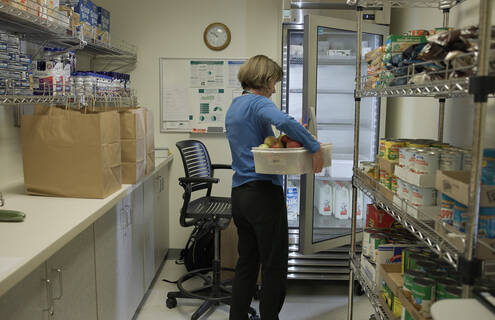
Thinking of donating food to your local pantry this holiday season?
“Fortunes change, sometimes without notice,” says Clinical Dietitian Nutritionist Jean M. Copeland, RDN, LD, who works for Dartmouth Health's Heart and Vascular Center. “As a rule of thumb, when donating food to a food pantry, consider your dietary needs, and donate these same foods.”
With that logic in mind, she provides these pointers.
Think about salt content
“Low-sodium or no-added-salt foods are often more expensive than regular varieties, so people with limited funds may not buy them, sacrificing their health,” she says.
But. she adds, the reality is that 45 percent to 57 percent of the American population has high blood pressure, which may be even higher in people who have food insecurity.
Her suggestions for healthier food donations include:
- Lower sodium or No-Salt-Added broth or stock
- Lower sodium or No-Salt-Added vegetables
- Lower sodium or No-Salt-Added tuna fish, sardines
- No-Salt-Added beans, lentils, chickpeas, etc.
- Lower sodium or No-Salt-Added soups
- No Added Salt peanut butter
- Unsalted or lightly salted nuts or seeds
Keep your own diet top of mind
Do you limit your sugar intake due to diabetes or pre-diabetes? Or do you need to avoid lactose, gluten, or other ingredients?
“People using food pantries have these same needs,” she points out.
So ask yourself: If you were unable to afford to feed yourself and had to rely on the local food pantry for help, what foods would you want from the food pantry?
Options might include:
- Canned fruit in water or own juice
- Dried fruit without added sugar
- Packets of sugar-substitute
- "Diet" Jello, pudding, cake mixes
- No-sugar-added fruit spread
Donate ingredients for cooking
Healthier ingredients make healthier foods.
“But on a tight budget, many food ingredients are not included in the grocery basket because they take a disproportionate amount from the food budget,” Copeland says.
These ingredients can be expensive but are both healthy and useful:
- Extra-virgin olive oil
- Toasted sesame oil
- Nuts of all kinds
- Seeds of all kinds (shelled pumpkin seeds, shelled sunflower seeds, etc.)
- Balsamic vinegar
- Bottles of lemon juice and lime juice
- Spices: cinnamon, nutmeg, cocoa powder, red pepper flakes, rosemary
- Seasoning Blends: Poultry Seasoning, Italian Seasoning, Herbs de Provence, Curry powder, Chili powder without salt
- Vanilla, almond extract, orange extract, peppermint extract
- Maple syrup
- Jars of minced garlic
Food pantries near you
Don’t know where to go?
Corbin Dameron, a former Schweitzer Fellow at the Dartmouth Cancer Center and now at Dartmouth’s Geisel School of Medicine, has also made this interactive map of every food pantry in Northern New England.
Before visiting a pantry, check its opening hours. Many pantries have websites that list hours and donation criteria, if any.
If you live in Vermont or New Hampshire, you can also call 2-1-1 to get information on food pantries and community fridges near you.
This story in The Valley News also lists food pantries.